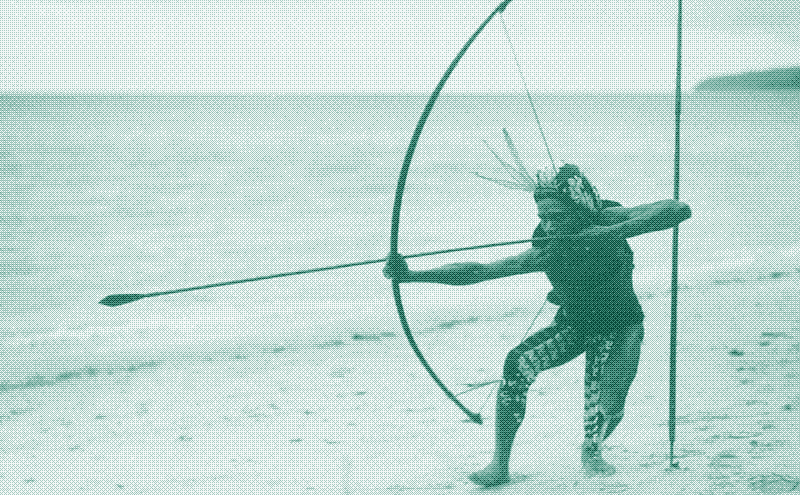
Many bows and arrows ago
The bow is one of humanity’s most essential and fascinating technologies, perhaps only eclipsed by the controlled use of fire. Despite endless academic speculation on the subject for almost 200 years, we don’t know when archery originated. 1 Bows and arrows were made from organic materials, which do not preserve for long. The oldest archaeological finds come from peat bogs, glaciers, and water-logged lake sediments – oxygen-free environments that prevent organic materials from decaying. 2 In the 1930s, in Stellmoor, Germany, archaeologists found roughly 100 arrow shafts dated to between 8,000 and 10,000 BC. 3 The oldest bow came to light in the 1940s in Holmegaard, Denmark. Scientists dated it to between 6,500 and 7,000 BC.
The bow and arrow are much older than these records indicate. One reason is that prehistoric bows were of a very sophisticated design, a point we return to later. Second, archaeologists have unearthed much older projectile points. The arrowhead is the only part of the bow and arrow made of inorganic material and thus preserves much longer. However, it can be hard to distinguish arrowheads from projectile points used with other weapons, most notably the spearthrower or atlatl. 45 While keeping this in mind, some studies have pushed back the date for the first bow and arrow use to between 35,000 and 70,000 years ago. 6 But even arrowheads cannot tell us the whole story because fire-hardened wooden points may have preceded bone and stone points.
Human powered springs
In mechanical terms, the bow is a spring made up of two flexible, elastic limbs held under tension by a string. When the archer pulls the string back, energy accumulates in the bow. When the archer releases the string, the energy transmits to the arrow, which flies out of the bow. The bow is a highly efficient technology: the arrow’s kinetic energy (usable energy) is close to the total energy expended. 78 Arrows are also very efficient, much more so than bullets: they lose little speed in flight and require little energy to penetrate a target. 9
The bow is a highly efficient technology: the arrow’s kinetic energy is close to the total energy expended.
The bow and arrow is a missile (or ranged) weapon for striking from a distance. Simple missile weapons are launched using unassisted bodily force, for example, thrown stones, throw sticks, or hand-cast spears (“javelins”). Complex missile weapons interpose a launcher between the human and the missile. Such weapon systems include the bow as well as the sling, the blowgun, the spearthrower, and the firearm. 4 In the hands of a skillful and muscular archer, the (pre)historical bow was a powerful and accurate weapon. The firearm replaced the bow because it was easier to use, not because it was technically superior. 9
Diversity of bow designs
Our forebears have used the bow and arrow on every continent except Australia (where spearthrower and throw stick prevailed) and Antarctica. The large geographical distribution and long history led to a wide diversity of bow designs determined by the local circumstances – the available materials and tools, the landscape, the climate, the use of the weapon, the social context, and so on. All bows consisted of a stave and a string, but the materials, dimensions, forms, shooting styles, and other features varied considerably. 1011 That is not the case with modern firearms, which are the same everywhere.
Essentially, there are two types of bows, opposites on a scale: the self-bow and the composite bow. Self-bows are made from a single stave of wood, while composite bows consist of several layers of various materials (usually wood, horn, and sinew). Other bows are somewhere in between. For example, laminated bows consist of several layers of the same material, and backed self-bows are hybrids between self-bows and composite bows. Self-bows dominated forested continents (Europe, the Americas, and Africa). Composite bows ruled in the drier regions (Middle East and Eurasia). Many intermediate forms probably emerged because of contact between different cultures.
Self-bows
The self-bow distinguishes itself by its durability and ease of construction, maintenance, and repair. It consists of a single (often straight) stave of wood. The most famous design is the longbow. As its name implies, the longbow is known for its length. It was about as tall as (or taller than) the archer who drew it. People often associate this bow type with the English longbow, which became an important battlefield weapon in the late middle ages. However, the longbow was used across Europe and other continents, while its design is much older. For example, Ötzi, the mummy found in the Italian Alps in 1991, carried a 182 cm longbow dating back to 3,300 BC. 12
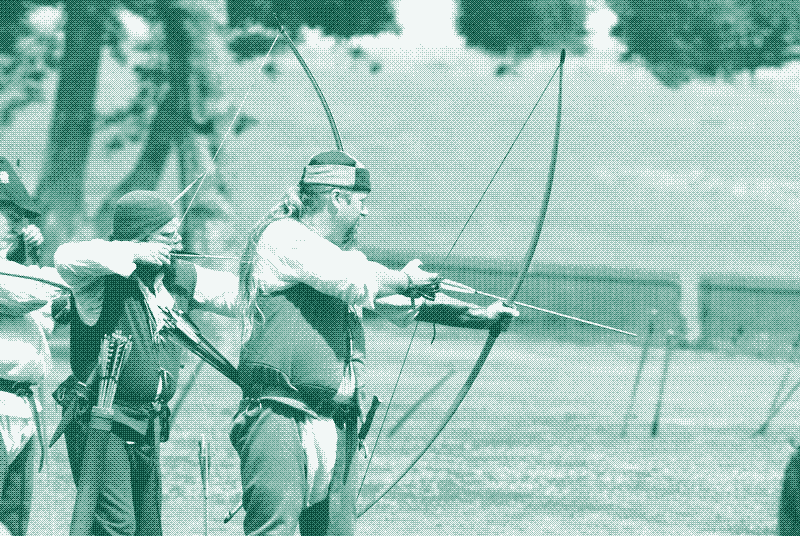
The historical longbow differs from the so-called longbows still used at archery ranges in the Western world. The British Longbow Society, formed in 1951, restricts the term longbow to a Victorian and Edwardian ideal when archery had become a recreational activity. Ironically, their narrow criteria exclude all historical longbows – even the famous medieval English war bows. 1013 “Modern” longbows are usually laminated bows with a stiff center section, while (pre)historical longbows were self-bows bending with a continuous arc. Modern longbows have an arrow rest cut out in the middle part of the bow (either left or right), but with historical longbows, the arrow often rested on the archer’s bow hand.
The second type of self-bow is the flat bow. It is only slightly shorter than the longbow but has a different cross-section. The longbow either has a circular shape or a D-shape. The English longbow, for example, has a flat “back” and a rounded “belly” – the belly being the side of the bow that faces the archer. In contrast, a flatbow is flat on both sides. Compared to the longbow, which has narrow limbs and is usually the widest at the handle, the flatbow has wider limbs but a narrow handle. 14
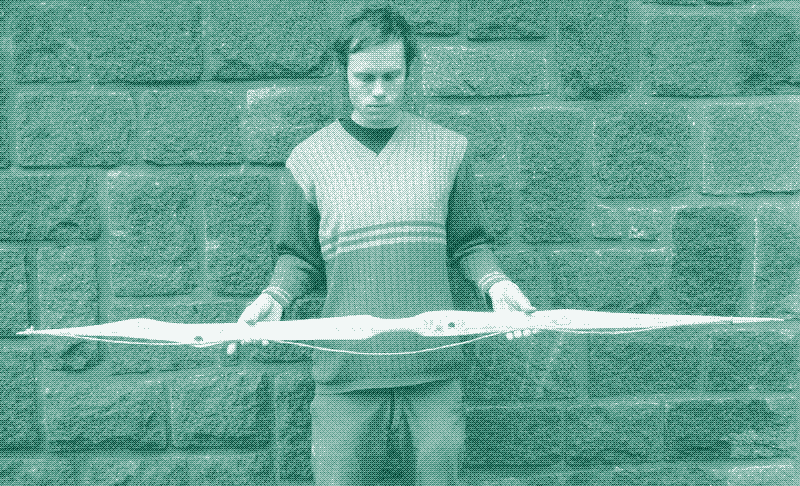
In the 1930s, American scientists set out to discover the optimal shape of a bow. To their surprise, they found that the D-shaped profile of the longbow – the only known historical western design at the time – is not the most efficient one. 14 Rather, a rectangular cross-section works best because it induces more uniform strain across the limb’s width. That makes the bow less prone to breakage.
The scientific discovery led to the design of the (recreational) American flatbow, which the scientists considered new. 15 In the 1940s, however, archeologists discovered the oldest prehistoric bow. It was a flatbow – the earlier mentioned Holmegaard. The Meare Heath bow, discovered in 1961 and dated to roughly 4,500 years ago, was also a flatbow. 1617 The American researchers also failed to notice that their innovation had been used for centuries by Native Americans. 14
Historically, the powerful draw of tall self-bows served for combat and hunting large animals. For hunting small game at close range, shorter hand bows (known as “small bows” or “birding bows”) were sufficient. These weapons were less powerful, used shorter and lighter arrows (often with blunt arrowheads), and were drawn to the breast instead of the ear. 13
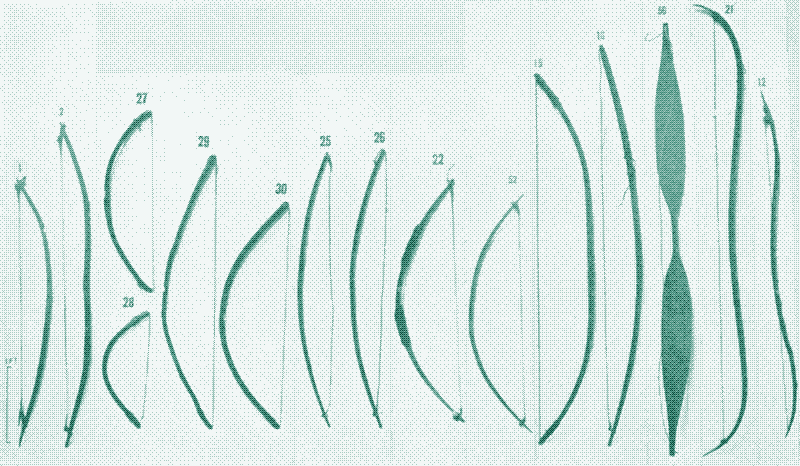
Tension and compression
For a bow limb to store energy, the wood must have both strength (to withstand tension) and elasticity (to withstand compression). If a bow is overdrawn, two things can happen. If the wood is stronger in tension than in compression, as it is usually, the wood fibers in the belly of the bow will compress, and the bow will not fully return to its original form. The wood has exceeded its elastic limit, and the power of the bow is forever reduced. On the other hand, if the wood is stronger in compression than in tension, overdrawing the bow will result in a splintered back or a fracture. 18
Some wood species are especially well-suited to make bows. Historical bowyers considered yew to be one of the best materials. 13 Yew grows (slowly) across many parts of the world. Its sapwood (the white wood on the outside of the tree just below the bark) excels under tension. Its heartwood (the redwood that makes up the center) excels under compression. Therefore, in a yew bow, sapwood forms the back, and heartwood forms the belly. 19 Another excellent bow wood is osage orange, native to North America, but it can thrive in many climates. Only heartwood is used – osage orange has high bending strength and elasticity. 20 Both wood species are also highly resistant to decay.
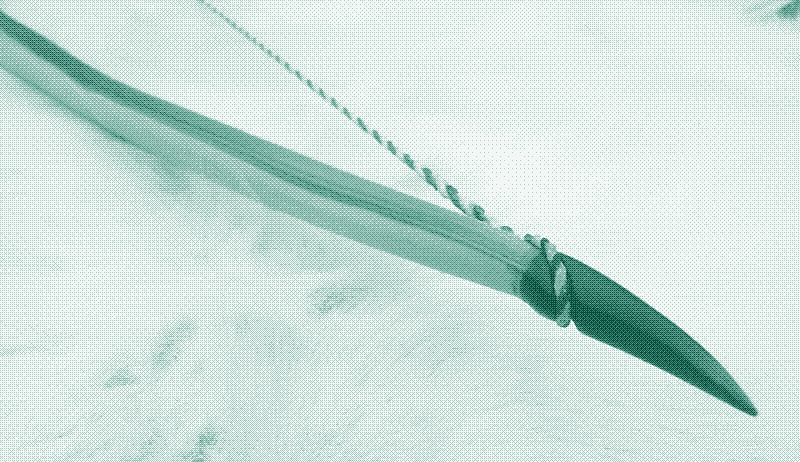
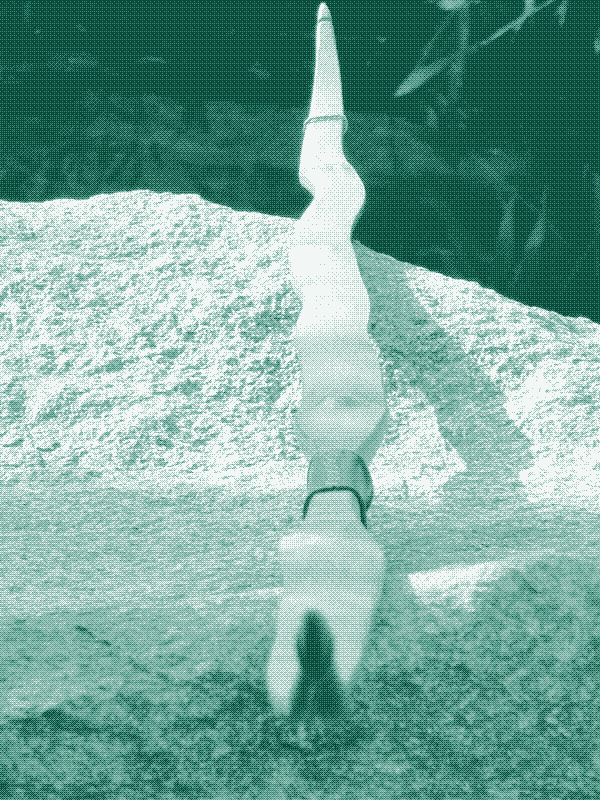
However, not all bows were made from yew or osage orange wood – far from that. Self-bows have been and can be made out of almost any type of wood, even wood that looks unlikely to make a bow. More important than the choice of wood is to match the design of the bow to the compression and tensile strength of a specific wood species. 21 A bow made of an inferior wood species can be protected from breaking or exceeding its elastic limit by adding more wood in the form of a longer or a wider bow. Bows made from excellent bow woods such as yew and osage orange have very narrow limbs, but bows made from weaker and less elastic woods can perform just as well with wider limbs. Less suitable bow wood also benefits from a rectangular cross-section (a flatbow design).
How to make a self bow
A self-bow can be made in a couple of hours – excluding the time to season the wood. It takes skill to make an excellent weapon, but building a crude self-bow is within everyone’s reach. Before metal tools were available, it was much easier to work wood that was still fresh and green. Therefore, seasoning wood took place after the bow was largely shaped. Once the wood had dried, the bow was finished with stone scrapers. The authors of the Bowyer’s Bible (a series of books that revived the interest in traditional archery during the 1990s) describe an experiment. They enter the forest with empty hands and come out with a bow that took them only six hours to make with stone-age tools: a rock, a self-made wood axe, and a fire. 14
Without metal tools, it took a lot of effort to cut down large trees to obtain bow wood. Some Native Americans invented an ingenious technique that involved prying bow staves from trunks and branches of living trees. 22They cut two V-shaped notches at the upper and the lower end of the intended stave, which was then left in the tree for several years until it had seasoned. Finally, they wrenched the stave from the tree using a lever and shaped the bow. Some old trees still show the scars of this process. Bowyers could exploit the same tree for bow staves over many centuries.
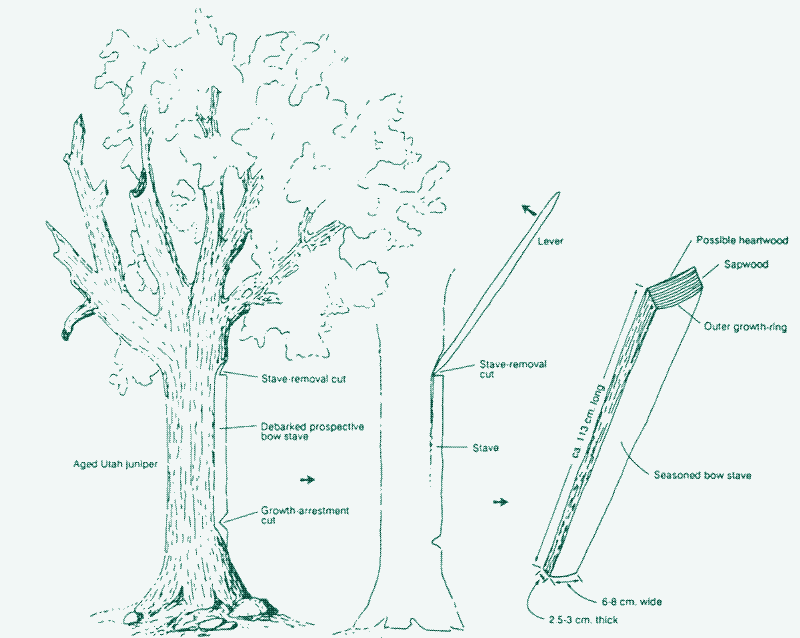
I could not find any references to bow stave trees in other regions, but coppicing and pollarding could also provide bow wood without cutting down entire trees. Yew trees were often pollarded. Another method was to plant them together in groups so they would grow straight up for perfect bow staves. When metal tools became available, harvesting bow wood and shaping a bow became easier. From then on, most bows were made from seasoned wood. However, the essential tools for a traditional bowyer have remained limited: a sharp hand axe, a wood rasp, and a scraper. 13142324
Shaping a self-bow comes down to following the grain and character of the wood. If using logs, the first step is to split them into halves or quarters, using a wedge so that the crack follows the grain. Each piece of wood dictates the style and shape of a self-bow. For example, if there’s a twist in a part of the bow stave, the design will follow it, resulting in a partly twisted bow. The central part of the self-bow-making process is “tillering”: the bow limbs are made thinner and thinner by taking wood away from the belly side, little by little, and taking care not to take away too much. The back of the bow remains unchanged and follows the split-off growth ring of the stave. 1325
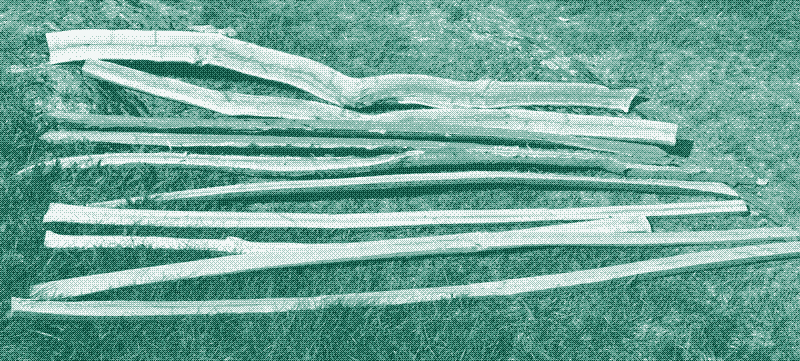
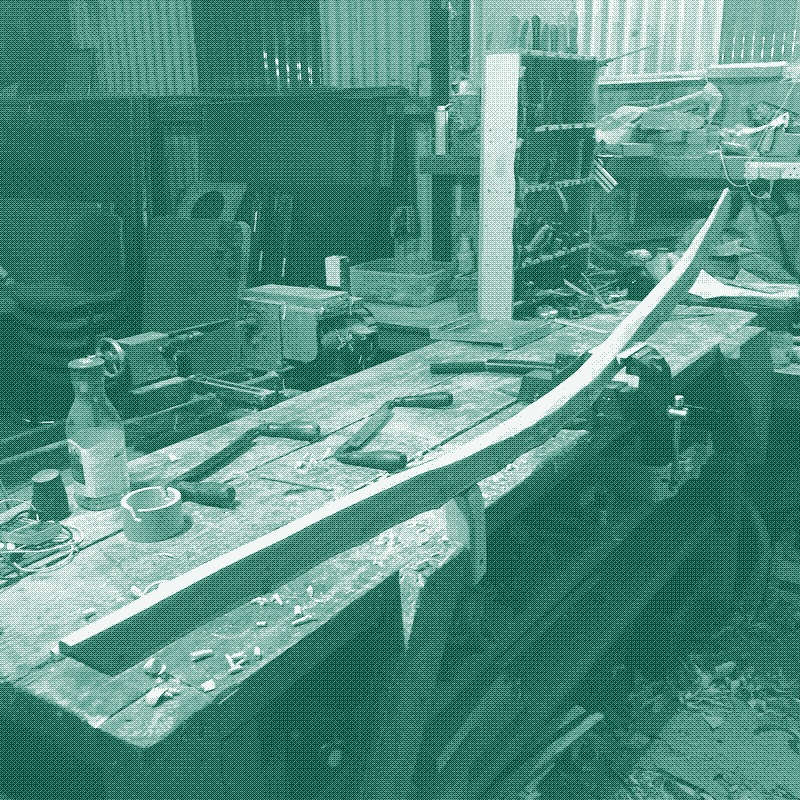
The composite bow
The composite bow is the opposite of the self-bow in almost any respect. Rather than taking material away, the composite bow consists of several layers of material glued together – usually wood, horn, and sinew (animal tendon or ligament). The bow is covered with bark or leather and sealed with lacquer. Rather than a long, straight stave, the composite bow is short (110 cm on average) and nearly always a recurve bow – a combination of reflex bow limbs (which bend away from the archer) and deflex bow limbs (which bend towards the archer). 726272829303132
In a composite bow, the wood mainly serves as a framework for building up the other layers. Horn (which is excellent in withstanding compression) formed the belly of the bow, and sinew (which has very high tensile strength) formed the back of the bow. The horn usually came from the water buffalo, abundant in regions where the composite bow was adopted. The sinew came from the backs of deer, antelope, or cattle (thick pieces lying along both sides of the ridge bones of the spine) or from the Achilles heel of cattle.
Because the combination of these materials performs better than even the best bow woods, a composite bow can bend with a larger arc in proportion to its length than a self-bow. Consequently, it can be made shorter than an equally powerful self-bow. That made it perfect for horseback, as the archer can easily switch the bow from side to side. Most cultures who adapted the composite bow were horse archers, and the weapon is also known as a horse bow. The composite bow was also the weapon of choice for the chariot archer, who predates the horse archer.
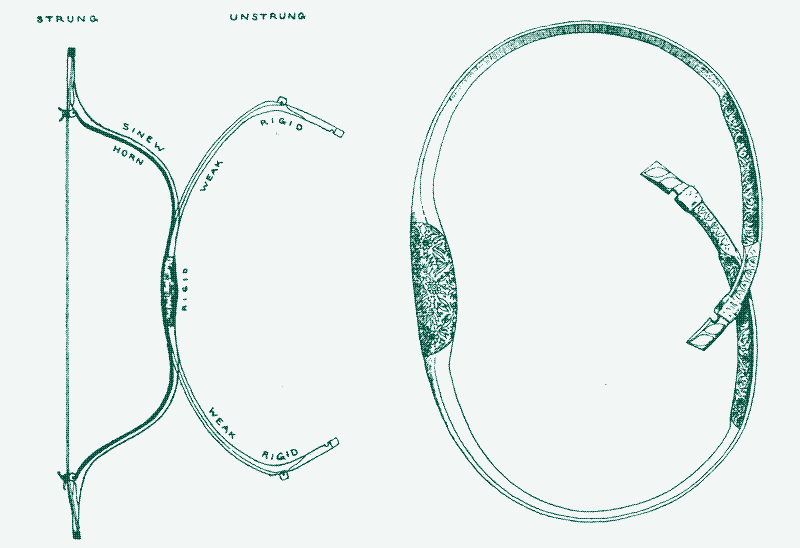
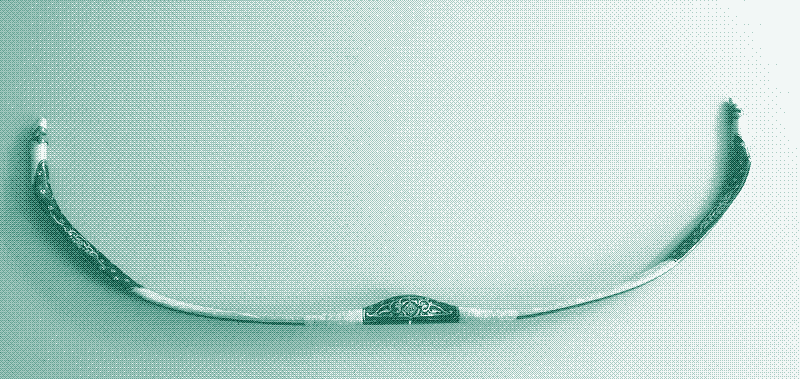
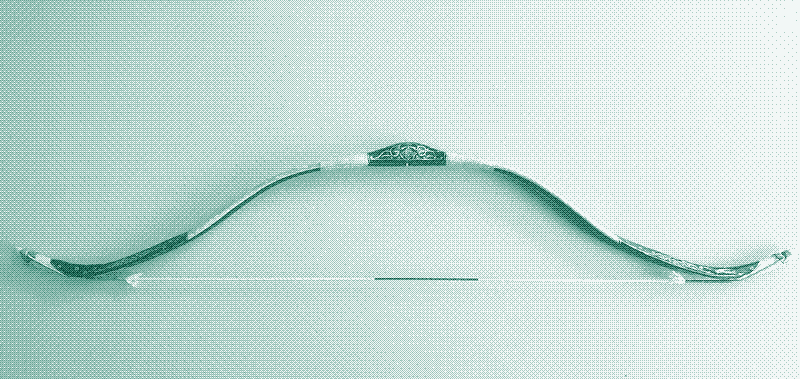
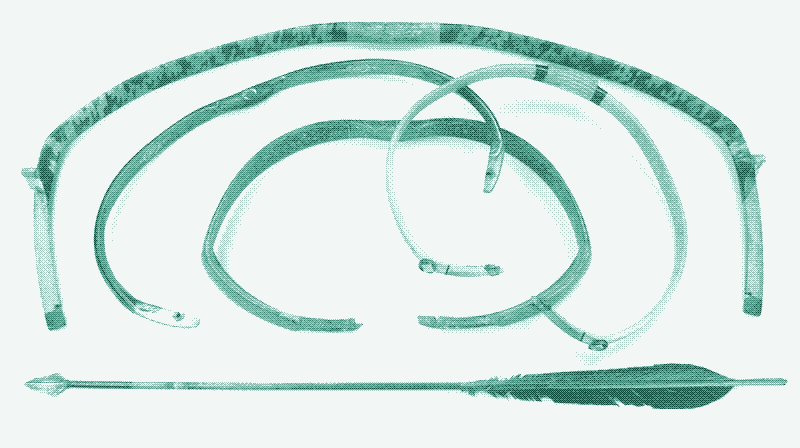
It seems most likely that the composite bow developed in Central Asia and then spread into India, North Africa, Russia, Eastern Europe, China, Korea, and Japan. We do not know how old the composite bow is. The oldest archeological finds date to 3,000 BC, but the region has less ideal conditions for preservation than Europe, where archeologists found the oldest self-bows. Unlike the self bow, which is usually a straight stave and only varies in its cross-section, the composite bow appears in an extraordinary diversity of bow designs. 26 Many composite bows had siyahs – non-bending levers at the end of the bow limbs that further increased the draw length and reduced the muscular power required to pull the bow.
How to make a composite bow
The composite bow is superior in performance to the self-bow. It can shoot arrows faster and farther with less effort. However, it takes more skill to use and requires a very elaborate manufacturing process. Making a composite bow takes 50 to 100 hours, spread over months or even years. 1826 The more powerful the bow, the more time it takes to make it. The bowyer dips bundles of sinew in warm glue and lays them lengthwise across the bow. Each layer of sinew has to dry before the next one can be put on. The bowyer gradually pulls the bow to longer and longer draw lengths, a few centimeters at a time until the bow tips touch or cross. Once the bow is complete, it is cured over a low fire.
The composite bow is also less durable and requires more maintenance than the self-bow. Its susceptibility to humidity requires continuous care – a composite bow needs to be kept warm and dry. In cold weather, archers stuffed the bows inside clothes and took them to bed. If possible, they warmed the bow over a fire before shooting. The Chinese (who built the largest composite bows) used dedicated warming cabinets to maintain or restore the recurve form lost during use. Composite bows also had to be protected from animals eating the sinew parts. Worms may eat the horn. 72627282930313233
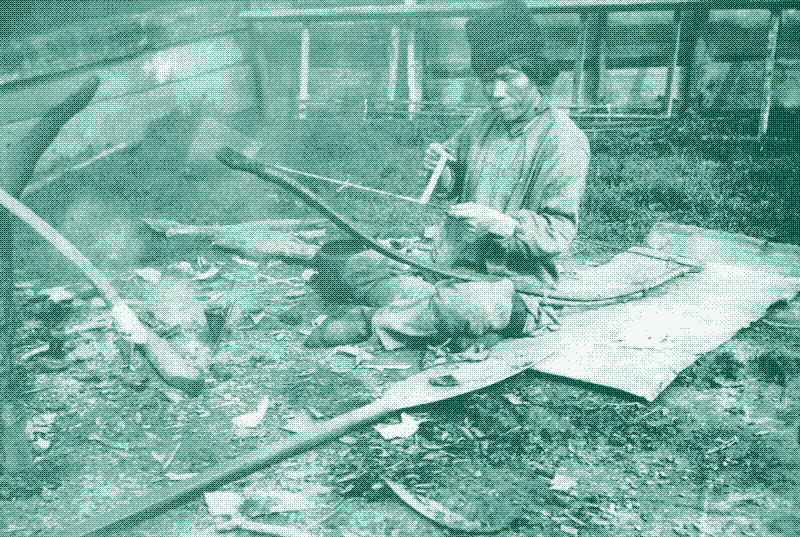
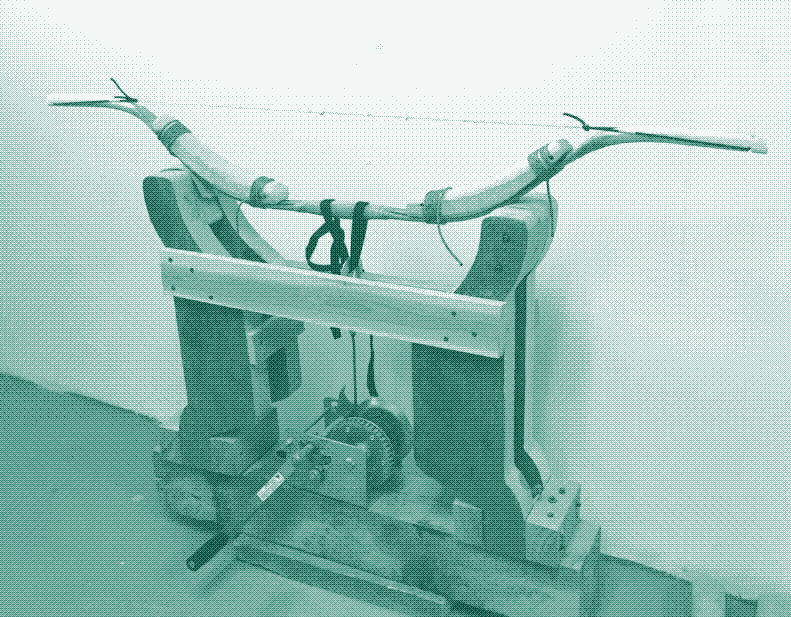
Backing: fusing the self and composite bow
To a certain extent, the advantages of the composite bow can be transferred to the self bow. Making a bow longer or wider is not the only way to make a powerful weapon from inferior wood. The other method is reinforcing or “backing” a bow. 3435 That involves gluing a material with high tensile strength on the back – the side of the bow facing away from the archer. The backing material can be sinew like in the composite bow. However, other materials work as well, or even better: rawhide, gut, skin, silk, and many vegetable fibers such as flax, hemp, or jute. Some reinforced bows were built of sinew-backed antler.
Backing allowed designs that were impossible to make in wood alone, such as short but powerful bows. Reinforced self-bows were common to indigenous peoples of North America 3637 When the Spanish introduced horses on the continent, Native Americans were quick to note the advantages of shooting from horseback, and adapted their bows by making them shorter – 90 to 110 cm. Being a simplified form of the Asiatic three layer construction, sinew-backed bows share some of the disadvantages. Backing increases the production time of a self bow to between eight and twenty hours, spread out over a period of two weeks to a month, and a reinforced bow needs protection against humidity.
In addition, adding a backing was a common way to repair a self-bow. If a bow developed a splinter on the back, gluing on rawhide, flax, or sinew could fix the problem. 35 If a bow had taken too much set – if it had exceeded its elastic limit – another technique could be used. The bowyer turned the bow around, letting the back become the belly, and applied backing to the new back (which used to be the belly).
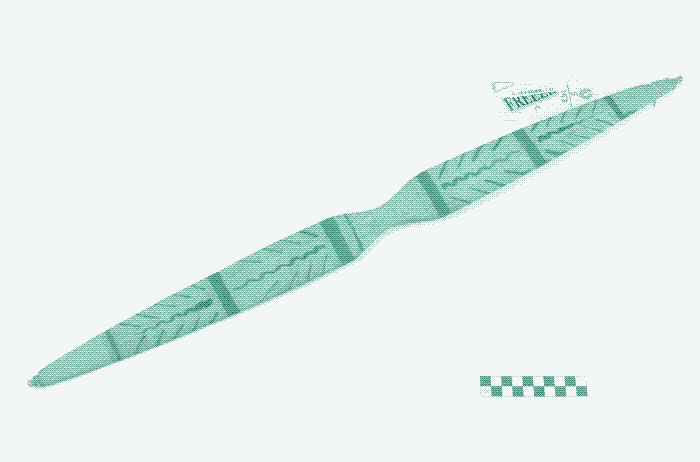
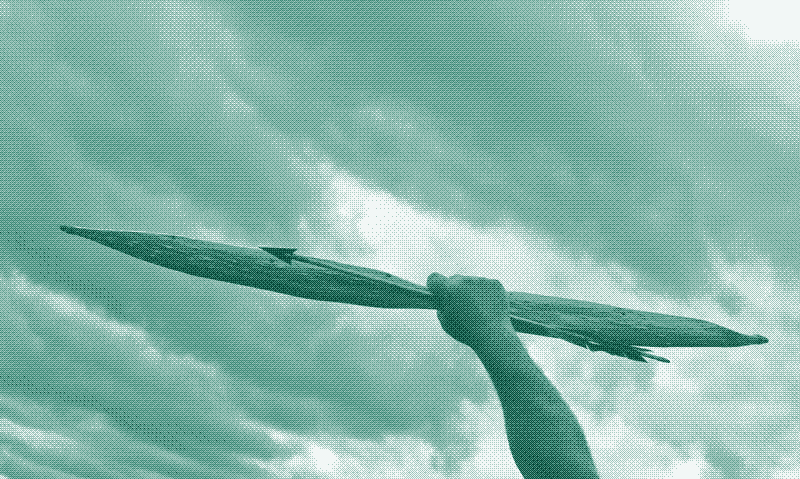
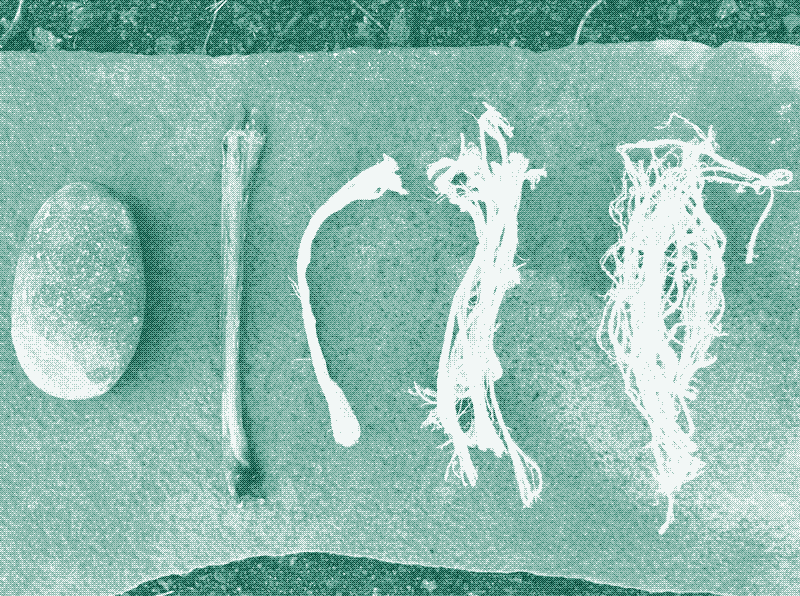
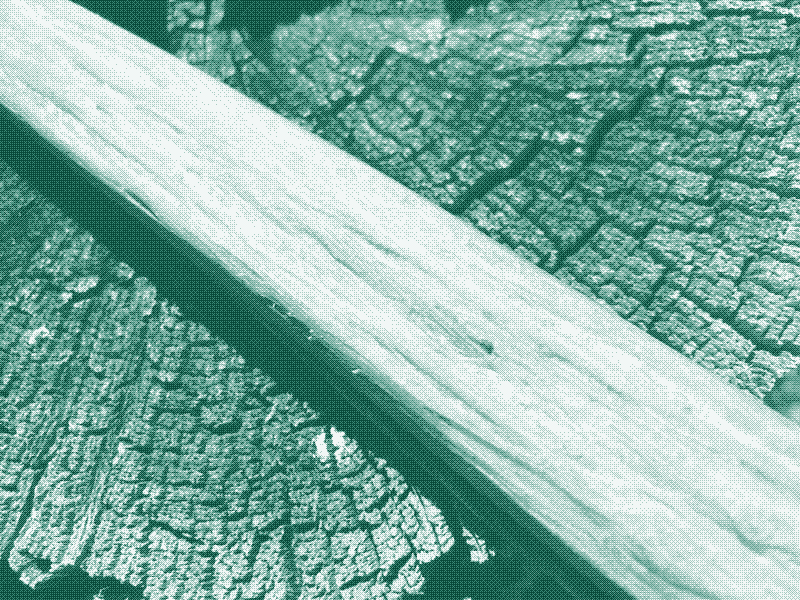
Cable-backed bows
The prize for the most inventive bow-making method goes to the Inuit, who faced two problems. First, they had a limited choice of bow wood. This was either driftwood, or spruce and fir, very brittle woods that lack elasticity. 1438 Second, animal glue is difficult to use in cold air, jelling almost instantly. The Inuit solved this by making bows from materials such as sheep horn, caribou antler, and baleen, which they reinforced by “cable backing”. This was the use of elevated sinew cables that ran up and down the limbs, fixed by an elaborate system of knots.
The backing consisted of a continuous stout twine made of sinew up to 45 meters long. The bowyer wrapped it around one of the bow nocks, ran it down the back of the bow, then wrapped it around the other bow nock, ran it up the back again, and so on, until several dozens of strands were on the bow. Next, the strands were twisted and fixed to the bow with knots in sometimes very complex patterns. Little flat rods served for twisting the cords. They were used in pairs, holding one in each hand to secure the same amount of twist in the two. 1438
Any backing must be proportional to limb mass across the bow, meaning it has to be thicker at the grip and thinner towards the bow tips. With a glued-on backing, this is easy to achieve: add more backing layers in the middle of the bow. However, it’s hard to reduce the diameter of a cable from grip to tip. The Inuit solved this by running part of the cables for just a portion of the limb length. Up to a dozen threads only extended across the middle of the bow. Most cable-backed self-bows were short flatbows – at most 125 cm long. 1438

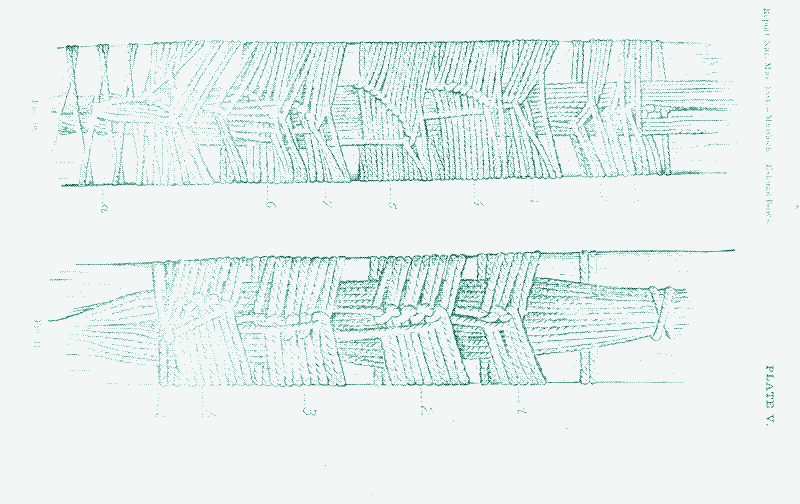
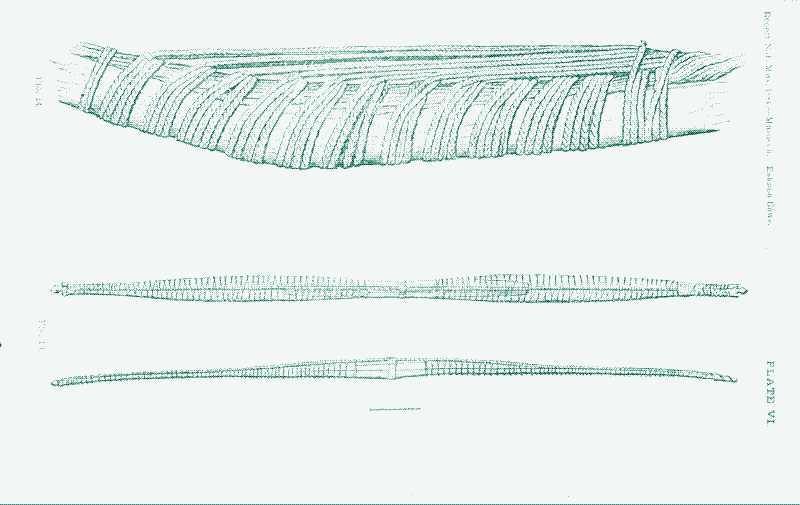
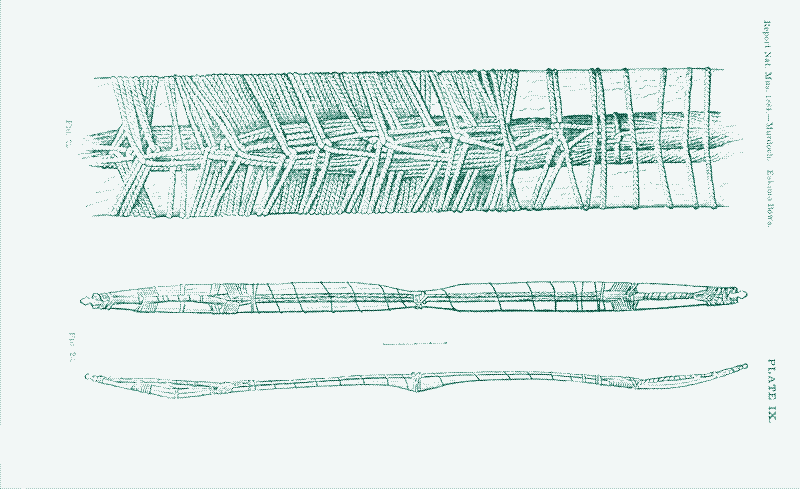
Cord bindings
Yet another method for making a bow out of inferior wood was the use of cord bindings. Rather than gluing a backing on the back of the bow, or stretching cables from one end to the other, cord bindings consisted of backing material that was wrapped around the bow.
A famous example of this technique is the Meare Heath bow. Found in 1961 in the peat bogs of Somerset, England, it dates back to about 2,690 BC. This flatbow – 6 cm wide and 190 cm long – had both transverse and criss-cross leather and sinew bindings. A replica of the bow – made with stone age tools – showed that it was an excellent weapon, surpassing the performance of the English longbow that appeared a few thousand years later. 17 Cord bindings continued to be used in the middle ages, also on some composite bows. 13 For example, the Hunza in Afghanistan wrap their entire bows with sinew. 10
Finally, there’s the Japanese bow, the yumi, which is a category of its own. The yumi is a laminated bow – made from at least seven layers of bamboo and wood – but its construction and design is clearly influenced by the composite bow. The yumi distinguishes itself by its length (it can surpass two metres) and its assymetry – the upper limb is two-thirds the overall length. The longer limb allows a longer draw while the shorter limb allows to shoot the bow from horseback or while kneeling. Making a yumi required the bowyer to use his hand and feet, working quickly with fast-drying glues that could be softened again in a steam tent. 10
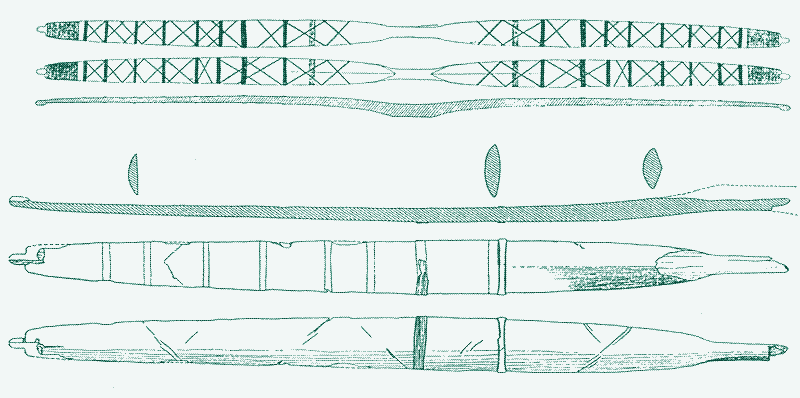
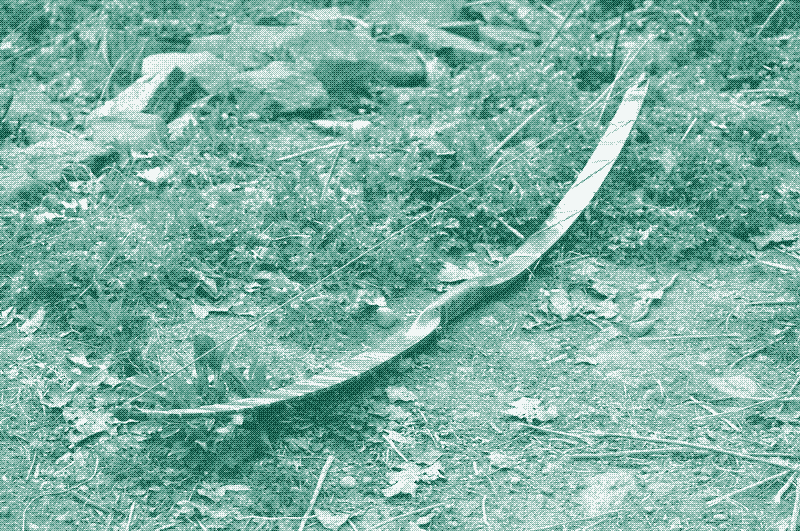
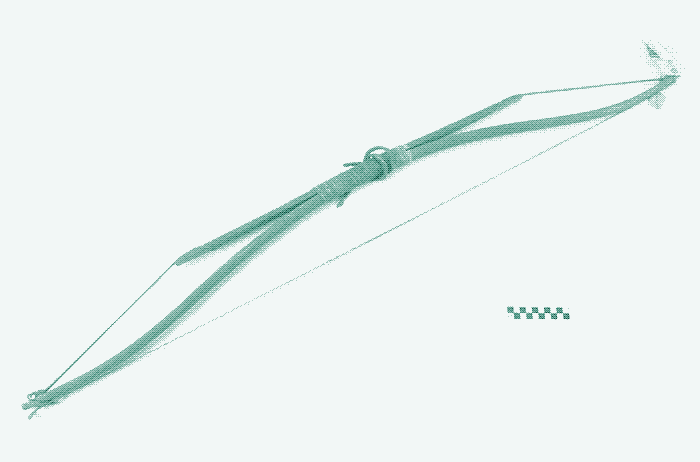
Growing arrows
By itself, the bow is not a useful weapon. It requires ammunition in the form of arrows. Finding wood for arrows was much easier than obtaining wood for bows. 133940 Most wood species make good arrows, and the wood can be shorter. Arrows were usually less than a metre long, except in the tropics, where they could be much longer. 41 Before the arrival of metal tools, arrow shafts were made from either shoots and saplings or cane, bamboo, and reeds – depending on what was available locally. These materials already have the shape of arrow shafts and grow in different lengths and diameters. 41
Shoots and saplings were debarked, straightened over a fire, finished, and then seasoned for a few weeks or months. These arrow shafts were solid and relatively heavy, which increased mass and penetration. Canes, bamboo, and reeds did not require debarking and were waterproof without further treatment. On the other hand, they were hollow and much lighter than shafts made from shoots and saplings. A separate foreshaft made from wood or bone was inserted into the hollow shaft to give them sufficient strength and mass. The nock was reinforced to prevent the bowstring from splitting the arrowshaft. 3940
Metal cutting tools gave birth to a new method, which allowed arrow shafts made from sawn timber. Wooden boards are cut into small squares the size of arrow shafts and then have their four corners shaven off, making them octagonal. These shafts are then rounded with sandpaper or sandstone. “Split timber shafting” reduced the time to make arrow shafts, made it possible to produce arrows in large numbers, and improved their ballistic capabilities. 394042
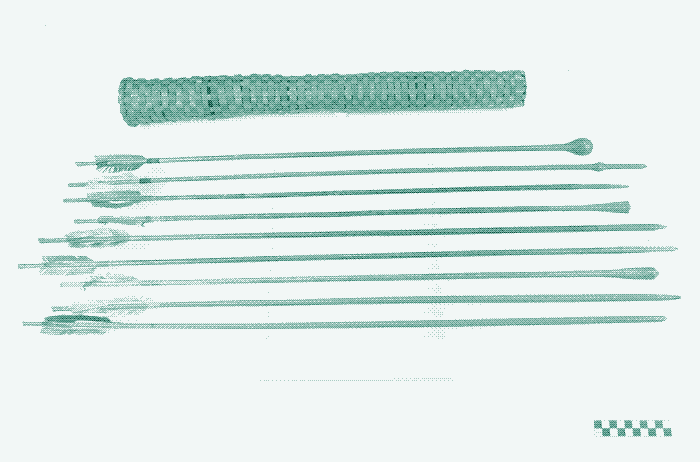

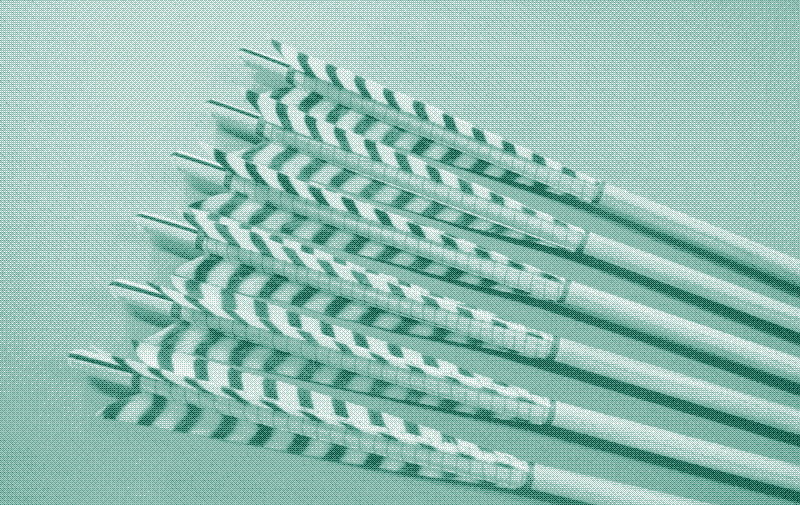



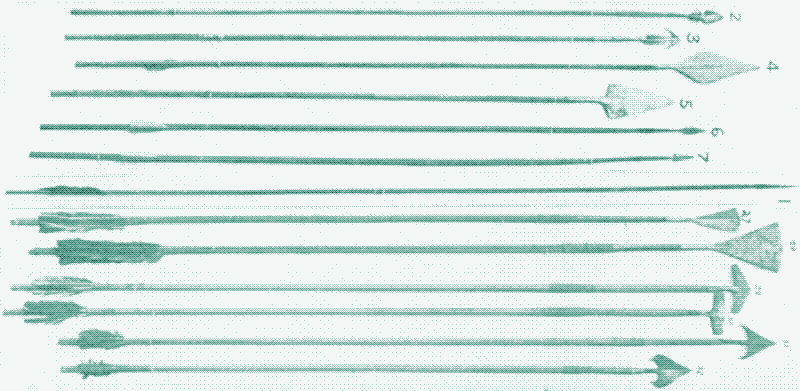
The shaft is the structural element of the arrow to which the arrowhead, the fletching, and the nock are attached. Historically, the nock was often cut into the shaft, sometimes reinforced with bone, horn, or hardwood. The fletching usually consisted of three feathers, which could come from many birds (such as goose and turkey). They were glued to the shaft and bound with sinew thread. 13
Arrowheads were made from many materials, including stone, bone, antler, teeth, and metal (bronze, wrought iron, steel). Metal arrowheads appeared most recently but did not perform better than arrowheads made from primitive materials. However, they were faster and more economical to manufacture. Wooden points remained in use through history alongside more durable but labour-intensive materials. 43 The shape of an arrowhead varied along with its use – hundreds of different types have existed. Arrowheads were fixed to the shaft with glue and a sinew binding, or inserted into a hollow shaft.
Reuse and repair of arrows
Making a set of arrows took considerably more time than making the average self-bow. However, archers routinely reused their projectiles. You can’t shoot a bullet, then put it back in a firearm and fire it a second time. However, you can launch the same arrow over and over again. That is evident in practice shooting, but it happened just as well during the hunt and on the battlefield. Arrows could change sides several times in a battle. They were picked up from the ground or extracted from dead enemies or comrades. 102944
Because they were valuable, even impaired arrows were routinely collected for repair. Limited repairs happened on the battlefield or during the hunt, and some fletchers could be attached to armies, extending the ammunition supply. If an arrow shaft broke close to the arrowhead – a common point of failure – attaching a new arrowhead was a quick fix to make a new, slightly shorter arrow. Even if the projectile became undersized for one archer, it could still serve a somewhat smaller archer. The Hazda, a tribe in Africa, used arrows that were longer than necessary and were cut shorter several times after breakage. 2
If the shaft broke in another place, it could be repaired by a more elaborate process called “footing.” This technique, which required metal tools, involved splicing with fishtail joints. Finally, arrowheads and feathers could be reused to make new arrows.
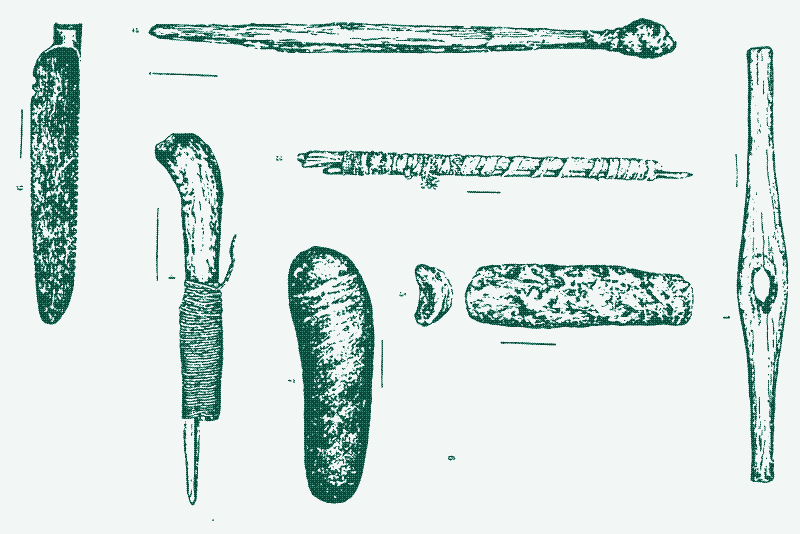
Growing bowstrings
The combination of a bow and a set of arrows is still not a weapon. The missing part is the bowstring, which brings the two together. Like bows and arrows, you can make strings from many different materials, and a suitable source of fiber is never far away. Historically, most bow strings were either made from vegetable fibers (hemp, flax, milkweed, ramie, nettle) or animal fibers (silk, sinew, rawhide, gut). Even human hair makes bow strings. Bowyers can grow their bow string material by planting some hemp or flax, which also provides material for backing bows and for making linseed oil – a traditional bow and arrow finish. 45
The Bowyer’s Bible dedicates a long chapter to making completely serviceable strings in the field even under the most primitive conditions: “Pull a fiber-bearing plant from the ground, pull a twig from a tree – for use as a spindle – and with this caveman’s gear, a thread can be spun finer and stronger than the finest machine-spun equivalent. With a little bit of practice, using a drop spindle, it takes about one and a half hours to spin a bowstring’s worth of thread. Using a spinning wheel, it can be done in twenty minutes. When spinning is complete, you are about fifteen minutes away from a flawless, first-class bowstring.” 45
Turning a thread into a bow string can be done in different ways. The “endless string” is the easiest to make. You drive two nails into a wooden board, and the distance between them equals the desired string length (a bit shorter than the bow itself). The string is winded back and forth around the nails until you reach the desired strand number – usually 12 to 16 strands. The two loose ends are then tied together, reinforced with a separate thread, and made into loops that can be attached to the bow nocks. In some regions, archers used knots rather than loops to attach the string to the bow, which allowed them to adjust the length of the bowstring. 45
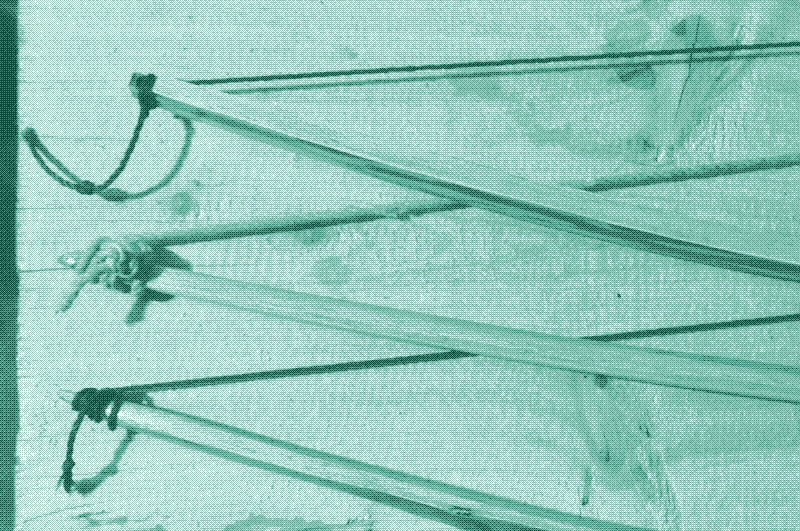

Do weapons need to be sustainable?
Historic and prehistoric bows and arrows were entirely made from natural and locally available materials. These came from plants and trees (wood, cane, bamboo, flax), animals (tendon, bone, feathers, glue), and minerals (stone and metal points). Nowadays, just like 10,000 years ago, one can walk into a forest or any other natural environment with empty hands and come out with a functional weapon. Even the tools to make it are in nature. The manufacturing is entirely human-powered, only aided here and there by a fire. Ammunition can be reused, repaired, and recycled.
That raises some questions. First, should weapons be sustainable? The use of bows and arrows was a perfect example of what we nowadays call the “circular economy.” In contrast, the manufacturing of modern firearms depends on a highly complex, globally interconnected, and interdependent supply chain, which consists of mines, factories, transport and power systems, fossil fuels, and parts of the economy such as finance and communication technology. Few of the materials required to make modern firearms are available locally or naturally, and the production creates waste and emissions. The same holds for modern bows and arrows made of metals, plastics, and synthetic composites.
Second, if it’s relatively easy to make lethal weapons, especially self-bows, why are we not plagued by waves of bow violence analogous to gun violence? There’s a lot of unease about 3D-printed firearms and “ghost guns” (unregistered firearms built up from anonymous gun parts), but how is that different from entering a forest with bare hands and coming out with a weapon that could kill an elephant? These days the choice of local materials has only grown. Any modern material that bends and returns can become a bow. You can make arrowheads from window or bottle glass, electronic modules, or old saw blades. 18 No firearm user can achieve the self-sufficiency of the preindustrial archer.
Third, if modern firearms depend on fossil fuels and a global supply chain, what if this context disappears? Could low-tech, artisanally made firearms compete with longbows, flatbows, and composite bows? In the following article, I try to answer these questions, and make a proposal: “What if we replace guns and bullets with bows and arrows?”.
Reactions
To make a comment, please send an e-mail to solar (at) lowtechmagazine (dot) com. Your e-mail address is not used for other purposes, and will be deleted after the comment is published. If you don’t want your real name to be published, sign the e-mail with the name you want to appear.
Reactions
Camille
Thanks a lot for this great article. What ressources would you recommend to start the crafting of a first longbow ? Is there a good step by step guide you know of ?
Kris De Decker
Hi Camille,
Although it is not a step by step guide, the best source to start is for sure “The Traditional Bowyer’s Bible”, especially the first three volumes.
xwindows
“The price for the most inventive bow-making method”
^ I think the word “price” is a typo, it should have been “prize”?
Anyway, thanks for the article; that is a lot of history tidbits that I’ve never known before.
Thomas
Very informartive and well-written article.
Thank you!
Ken Wee
Nicely researched and illustrated and written article. I wonder about the right five bows illustrated in the photo of African bows. They (bows #15, #16, #56, #21 and #12) look like Native American ones. #56 reminds of bows by California Indians - sinew backed yew “paddle” shaped bows. Keep up the good work and thanks for sharing.
David
there is a source for ancient weapons,bow and arows,etc
brought to us curtisy of global warming
the edges of melting glaciers are proving to be reliable
hunting grounds for ancient artifacts
so much so that ,indiginous teachers are conducting field trips
for their youth,and the finding of artifacts creates a powerfull
bond with there ancestors
Peter
The best method of learning to make a bow and arrow is by doing. TBB (Traditional Bowyer’s Bible, all volumes, not just 1-3) are a near-perfect source of information. Most regions of the world with trees have suitable “bow wood” with the understanding practice makes perfect. Likewise, a local hardware store selling lumber can provide countless stave material. There are countless tutorials on building bowstrings, too. When it comes to arrows, bamboo is a prime source, keeping in mind prospective arrow shafts should be cured beforehand. Additionally, the joints in bamboo, river cane, etc can be straightened using a candle, fire, etc- heat gently, bend straight, then wipe down with a damp rag. This also tempers the joint so the nodes and sections form a contiguous straight shaft. When affixing an arrowhead, I advise using “modern equivalents” such as cotton thread with cyanoacrylate or similar adhesive when starting out. Shooting “off the knuckles” with traditional selfbows also warrant similar treatment with thread and glue to ensure a smooth transition over glove or bare skin. I’ve made red oak and pine-board bows that surpass my “store bought” models in terms of fun and sustainability.
My “Parthian shot” aka parting thought: One can even fabricate powerful fast bows replicating the Holmegaard and horsebows using schedule 80 PVC and sections of broomstick. I have a 38# draw-weight bow made in such fashion and use it for small-game hunting (rabbit, etc) using scraps left over from my days working in construction. Once you understand the “how”, the rest follows based on materials on hand.